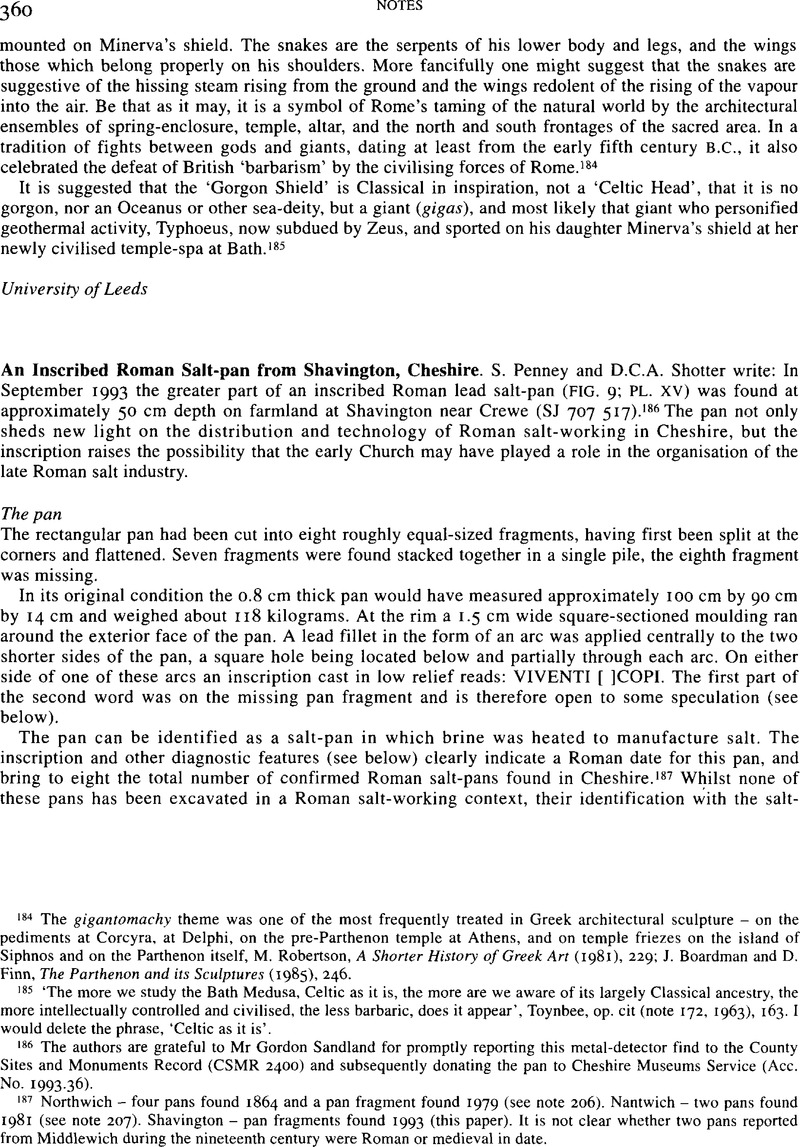Published online by Cambridge University Press: 09 November 2011

184 The gigantomachy theme was one of the most frequently treated in Greek architectural sculpture on the pediments at Corcyra, at Delphi, on the pre-Parthenon temple at Athens, and on temple friezes on the island of Siphnos and on the Parthenon itself, M. Robertson, A Shorter History of Greek Art (1981), 229; J. Boardman and D. Finn, The Parthenon and its Sculptures (1985), 246.
185 ‘The more we study the Bath Medusa, Celtic as it is, the more are we aware of its largely Classical ancestry, the more intellectually controlled and civilised, the less barbaric, does it appear’, Toynbee, op. cit (note 172, 1963), 163. I would delete the phrase, ‘Celtic as it is’.
186 The authors are grateful to Mr Gordon Sandland for promptly reporting this metal-detector find to the County Sites and Monuments Record (CSMR 2400) and subsequently donating the pan to Cheshire Museums Service (Ace. No. 1993.36).
187 Northwich – four pans found 1864 and a pan fragment found 1979 (see note 206). Nantwich – two pans found 1981 (see note 207). Shavington – pan fragments found 1993 (this paper). It is not clear whether two pans reported from Middlewich during the nineteenth century were Roman or medieval in date.
188 A.F. Calvert, Salt in Cheshire (1915), 71 ff.
189 It should be noted that misleading information concerning the Nantwich pans has appeared in print. The initial publication of the finds erroneously described the suspension-holes as ‘pouring holes’ (Britannia xv (1984), 342).Google Scholar The suspension-holes have been omitted from the published drawings of the pan inscriptions (see note 199).
190 G. Twigg, Open Pan Salt Making : a Glossary of Terms (1993), 22.
191 Tool identification by Professor W.H. Manning of University College, Cardiff, based on photographs and silicon impressions supplied.
192 RIB 2416.2–3.
193 There is a single Viventius cited in Volume I of the Prosopography of the Later Roman Empire. This Viventius is from Pannonia, and evidently a Christian (Ammianus Marcellinus XXVI.4.4), who rose to be Quaestor Sacri Palatii in A.D. 364, Praefectus Urbis Romae in A.D. 365–7, and Praefectus Praetorio of the Gauls in A.D. 368–71; he died before A.D. 384.
194 Thomas, C., ‘The early Christian inscriptions of southern Scotland’, Glasgow Arch. Journ. xvii (1991), 1–10.CrossRefGoogle Scholar The authors are extremely grateful to Professor Charles Thomas for bringing to their attention the examples of the name Viventius quoted in this paper.
195 A.R. Birley, The People of Roman Britain (1979), 153–4.
196 K.S. Painter, The Water Newton Early Christian Silver (1977).
197 RIB 2416.6.
198 RIB 2416.5.
199 Petch, D.F., ‘The Roman Period’, in Harris, B. (ed.), VCH (Cheshire) 1 (1987), 115–236.Google Scholar
200 RIB 2416.2–3.
201 Monogamia 12. The authors are grateful to Professor Charles Thomas for his most helpful comments on the use of clerus.
202 Clarke, L.C.G., ‘Roman pewter bowl from the Isle of Ely’, Proc. Camb. Antiq. Soc. xxxi (1931), 66–72.Google Scholar
203 A. Notholt and D. Highley, Salt: Mineral Dossier No. 7 (1973).
204 Morris, E., ‘Prehistoric salt distribution: two case studies from western Britain’, Bull. Board Celtic Stud. xxxii (1985). 336–79.Google Scholar
205 J.D. Bestwick, ‘Romano-British Inland Salting at Middlewich (Salinae), Cheshire’, in K. de Brisay and K. Evans (eds), Salt: The Study of an Ancient Industry (1974), 66–70.
206 Kendrick, J., ‘Notes on leaden salt-pans discovered in August, 1864, at Northwich, Cheshire’, Trans. Hist. Soc. Lanes, and Cheshire(n.s.) vi (1865), 9Google Scholar; op. cit. (note 199), 202.
207 op. cit. (note 199), 209; RIB 2416.2–3.
208 W.T. Watkin, Roman Cheshire (1886), 313.
209 Price, J., ‘The discovery of an early saltworking site near Crewe’, Cheshire Past iii (1994), 4.Google Scholar
210 Dodgson, J. McN., The Place-Names of Cheshire 1 (1971), 38.Google Scholar As noted by Dodgson, it is possible that this reference could relate to a salt-house at Nantwich belonging to Shavington Manor.
211 By 1839 (Tithe Award) this field had been sub-divided into Big Wall Field, Wall Field, and Little Wall Field.
212 op. cit. (note 199), 209.